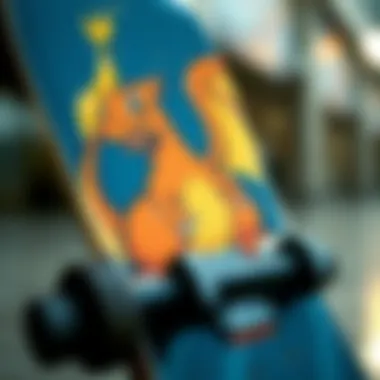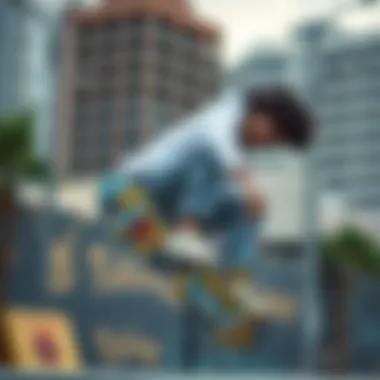The Evolution and Impact of Pokémon Skate Decks


Intro
In the kaleidoscopic world where skateboarding and Pokémon converge, a unique niche emerges that captures the essence of childhood nostalgia while resonating with the rebellious spirit of skaters. The evolution of Pokémon skate decks is not just a trend; it is a phenomenon that garners attention from collectors, enthusiasts, and casual skaters alike. Once mere pieces of merchandise, these decks have blossomed into symbols of personal expression, embodying the spirit of both Pokémon's whimsical universe and the street culture of skateboarding.
The 1996 debut of Pokémon turned a simple video game franchise into a global juggernaut. Skating, on the other hand, traces its roots back to the early 1950s, evolving into a form of art and culture that speaks to freedom, creativity, and community. Together, they create a dialogue that reshapes perceptions while appealing to multiple generations.
This intersection is not just about graphics plastered on wooden decks; it encapsulates a movement where design aesthetics play a critical role. From the iconic Pikachu to the elusive Charizard, the art on these decks becomes a canvas that skaters showcase each time they hit the pavement. The cultural significance of Pokémon skateboards stretches beyond aesthetics; it delves into community responses and market trends that shape this ever-evolving landscape.
In this exploration, we will dive deep into key elements that highlight how Pokémon skate decks carve out their space in skate culture, dissecting their impact on both the skater and the collector. Not only will we examine the history and aesthetics, but we will also look at the personal stories behind these decks, examining how they have nurtured a sense of belonging among skaters while merging two distinct cultural spheres.
Foreword
The world of skateboarding mixes artistic expression with a distinct culture that thrives on personal identity. When combined with the whimsical charm of Pokémon, a phenomenon that has captured hearts since its inception, we find a unique niche that resonates on multiple levels. The injection of Pokémon into skate decks has transformed them from mere sporting equipment to canvases of nostalgia, tapping into the childhood memories of a generation. This article will explore how these decks became artifacts of expression while examining their underlying impact on skater identity and community.
Defining Pokémon and Skateboarding
At its core, Pokémon originated as a video game franchise, inviting players to capture creatures known as Pokémon for battle. This concept grew into an expansive universe encompassing trading cards, animated series, movies, and more. Fans have attached deep emotional ties to characters, creating a passion that transcends traditional gaming.
On the other hand, skateboarding represents rebellion, creativity, and individualism. Emerging from the streets, it’s not just a sport but a lifestyle. Skaters often view their boards as extensions of themselves, choosing designs that reflect their personality. The fusion of Pokemon with skateboards isn’t just about a cool design. It represents a cultural mash-up where childhood nostalgia meets the boldness of skate culture.
Both Pokémon and skateboarding symbolize freedom, adventure, and self-expression, making their union a compelling intersection.
The Cultural Significance of Skate Decks
Skate decks have evolved into more than just tools for tricks. They are prized possessions, collectible items, and art pieces. In the realm of skater culture, the deck is often a way to convey personal style and social status; unique designs can set a skater apart from their peers. Skateboarding brands have recognized this, creating limited-edition decks that not only serve practical purposes but also appeal to collectors and enthusiasts.
The rise of Pokémon-themed decks marks a significant moment in skater culture. Rather than simply tapping into nostalgia, these decks represent a broader dialogue about identity. They become part of youth culture and community interactions. When a skater rides a Pokémon deck, it creates a connection with both the world of Pokémon and the skateboarding community.
Blending childhood memories with the thrill of skating leads to a unique sense of belonging that few other items can replicate.
The Historical Context of Pokémon
Understanding the historical context of Pokémon is essential for grasping how this franchise has not only shaped a generation but also influenced various domains, including skate culture. Since its inception, Pokémon has woven itself into the fabric of childhood experiences, merging gaming, trading, and community. This section highlights the milestones that shaped Pokémon's trajectory, revealing its evolution from a simple concept to a cultural phenomenon.
The Birth of Pokémon
Pokémon was first introduced to the world in 1996, born from the creative minds of Satoshi Tajiri and Ken Sugimori. Initially, it was conceived as a video game for the original Game Boy, providing players with the ability to capture and train fantastical creatures. This concept resonated deeply with audiences; kids found themselves drawn into a universe where friendship, adventure, and competition reigned supreme. The simple tagline, "Gotta Catch 'Em All!" echoed this spirit of exploration and collection, sparking an expansive franchise that now includes trading cards, an animated series, movies, and more.
The success was not merely commercial; it represented a shift in how children interacted with gaming. Instead of isolated play, Pokémon encouraged social engagement through trading and battling, laying the groundwork for a fan culture that has persisted for decades.
Pokémon's Evolution in Popular Culture
As the years rolled on, Pokémon matured alongside its audience. What began as a game quickly expanded into a cultural juggernaut, capturing the imaginations of millions around the globe. The anime adaptation introduced Ash Ketchum and Pikachu, making Pokémon household names. Kids rushed home after school to watch their favorite episodes and discuss the latest Pokémon finds on playgrounds or online forums.


The game continued to evolve, too. With each new generation, new Pokémon introduced further encouraged collecting, nostalgia, and community discussions. Events such as Pokémon Go's release in 2016 demonstrated that the franchise could adapt and thrive in contemporary settings, merging augmented reality with the core elements of the Pokémon universe.
The Rise of Skateboarding
Similarly, the skateboarding culture saw its rise around the same time as Pokémon's inception. By the late 1980s and early 1990s, skateboarding transformed from a niche hobby into a prominent subculture, complete with its own style, music, and lifestyle. Skateboarding was about more than tricks; it was about individual expression, community, and carving out space within urban environments. It became synonymous with rebellion, creativity, and a unique cultural identity.
This parallel growth created an intriguing intersection between Pokémon and skateboarding. As Pokémon entered its stride, it captured the attention of skaters, many of whom were children in the late '90s and early 2000s. This melding of interests eventually led to the creation of Pokémon-themed skate decks, transforming not just how fans expressed their love for Pokémon but also how they engaged in the sport.
The Convergence of Pokémon and Skateboarding
The intersection of Pokémon and skateboarding represents a vibrant synthesis of nostalgia, creativity, and cultural expression. Each phenomenon boasts its own deep wells of community, but together, they create a unique space that resonates with both longtime fans and new enthusiasts alike. Understanding the convergence of these two spheres is crucial in examining how Pokémon skate decks not only serve as collectible items but also as a canvas for personal identity and communal belonging.
The First Pokémon Skate Decks
When it comes to the initial foray of Pokémon-themed skate decks, one cannot overlook the pioneering efforts of companies that sought to tap into the burgeoning skate culture of the late '90s and early 2000s. The first decks often featured art that echoed the vibrant colors and playful designs found in Pokémon cards. In those days, Element Skateboards launched the first officially licensed Pokémon skateboards. Images of Pikachu and Charizard adorned the boards, creating instant appeal among kids who were hooked on both skateboarding and catching 'em all.
Several skate shops acted as catalyst for the trend, attracting a new generation of skaters who were eager to showcase their love for Pokémon through their gear. The decks weren't just boards for skating; they were fashion statements and symbols of one's passions. Young skaters would often talk about how they chose their board colors and designs to reflect their favorite Pokémon—creating a sense of flair that merged gameplay figures with street sports.
"These first decks were more than just skatable equipment—they were extensions of our personalities, displaying who we were and what we loved," says a long-time skater who recalls the impact of those early designs on his skateboarding journey.
Key Brands and Collaborations
As time marched forward, several notable companies jumped on the bandwagon, propelling the phenomenon into new heights. Plan B Skateboards, known for their innovative approach to skate design, launched a limited edition series featuring artwork from the Pokémon franchise. They collaborated with well-known artists who reimagined classic Pokémon characters, blending skate culture with artistic visions.
Here are a few key players involved in this crossover:
- Santa Cruz Skateboards: Famous for their graphic-heavy boards, Santa Cruz integrated Pokémon themes into their decks, capturing both the hearts of skaters and Pokémon fans.
- Creature Skateboards: Showed off a special series of decks featuring darker Pokémon designs that appealed to a more mature audience, broadening the demographic of collectors.
- Independent Trucks: Partnered with Pokémon in special runs of skateboard trucks, allowing fans to personalize their setups.
These collaborations were instrumental in cementing the popularity of Pokémon skate decks across diverse age groups. They emphasized that skateboarding was not merely an activity but a lifestyle—a subculture thriving on creativity, personal expression, and community.
The melding of design and function in this context also paved the way for discussions about artistic integrity in skateboarding. Despite being merchandise, these decks have transcended mere commercialism, often regarded as collectible art.
Art and Design in Pokémon Skate Decks
The visual aspect of Pokémon skate decks is more than just eye candy; it represents a vibrant blend of nostalgia and contemporary skate culture. Each layer of design offers an avenue for artistic expression, which resonates deeply with both skaters and Pokémon enthusiasts alike. Understanding the art and design within this niche not only highlights its aesthetic value but also serves to reveal the emotional connections that people forge with their skate decks.
Aesthetic Appeal
At first glance, the aesthetic appeal of Pokémon skate decks captures attention through colorful graphics and striking patterns, pulling you in like a moth to a flame. These decks reflect artistic creativity by integrating playful designs featuring beloved Pokémon characters seamlessly with the rugged authenticity of skateboarding. Using high-quality materials ensures that these decks don't just look good, but they also stand the test of time against wear and tear. Envision a sleek Charizard soaring across the surface of a deck, the flames flickering in vibrant oranges and reds against a cool black background. This visual juxtaposition not only enhances the skate experience but also sparks conversations among skaters, making them feel part of a larger community that cherishes both the game and the sport.
Iconic Pokémon Imagery
When it comes to Pokémon imagery, we cannot ignore its undeniable impact on the skateboarding scene. Characters like Pikachu, Bulbasaur, and Mewtwo are not merely mascots; they symbolize a fundamental aspect of many people's childhood. This nostalgic connection is powerful and palpable. Skaters often choose decks adorned with their favorite Pokémon to express their identity and preferences, which can serve as a reflection of their personality.
The choice of imagery also plays a significant role in brand identity. Well-known skate brands, such as Element and Toy Machine, often lean towards iconic Pokémon visuals to create decks that speak to both skateboarding culture and Pokémon fandom. The infusion of these designs gives rise to collectibles that often carry a higher intrinsic value over time, creating a market that thrives on rarity and demand.


Personalization and Custom Decks
One of the most fascinating aspects of Pokémon skate decks is the endless potential for personalization. Skaters delve into customizing their decks, turning a standard piece of wood into a canvas of self-expression. Some individuals may opt to hand-paint or apply vinyl graphics featuring unique Pokémon designs that resonate specifically with them. This level of personalization allows for stories to be told, making each deck a one-of-a-kind artifact.
Additionally, various online platforms and local shops offer services to create custom designs. This burgeoning trend signifies a shift towards individuality within the skateboarding community. Every scratch, dent, and color adds layers to a skater's identity; thus, personalization transcends mere aesthetics and becomes a medium for sharing one’s journey.
"A deck with a unique design not only reflects one's personal style but becomes a collector's item, carrying memories of every trick and fall."
Market Trends and Collecting
The interplay of market trends and collecting is pivotal in understanding the dynamism surrounding Pokémon skate decks. This phenomenon is not merely a trend but showcases how pastimes intertwine with nostalgia and cultural identity. Collecting these uniquely designed decks reflects a deeper connection to the Pokémon universe and the skate culture that many enthusiasts embrace. The ability to collect implies not just possession but also an investment in experiences and memories that resonate with skaters of all ages.
Collectibility of Pokémon Skate Decks
The collectibility of Pokémon skate decks speaks volumes about their cultural significance. With their vibrant graphics and iconic characters, these decks have quickly become coveted items. Skaters often seek these decks not only as functional skateboards but as aesthetic pieces worth displaying.
- Rarity: Limited editions often create a buzz, driving collectors to hunt them down relentlessly. Certain decks featuring beloved Pokémon like Pikachu or Mewtwo can fetch prices significantly higher than their original retail value, depending on their condition and availability.
- Nostalgia Factor: Many skaters grew up with Pokémon; thus, owning a piece that combines two passions—skating and their childhood favorite franchise—fuels demand. This nostalgia often leads to increased appreciation and willingness to invest in these decks.
- Influence of Art and Design: Many collectors value the artistic merit of the designs themselves. Decks showcasing innovative artwork or collaborations with notable artists attract attention and tend to hold or increase in value over time.
Resale Markets and Valuation
The realm of resale markets for Pokémon skate decks has amplified the entire landscape for collectors and skaters. Platforms like eBay and specialized skate shops have made it easier for collectors to buy, sell, and trade decks as market values can fluctuate dramatically.
- Market Trends: Like any collectibles market, there are ups and downs influenced by external factors such as media coverage of Pokémon events or the introduction of new game releases. Seasonal trends also play a role; for instance, during holiday seasons, demand for Pokémon merchandise surges, impacting resale prices.
- Valuation Factors: Condition, rarity, and demand dictate a deck’s valuation. A deck in pristine condition, especially if it’s part of a limited series, can rise sharply in resale value. Knowledge of market trends and staying informed about sales on platforms is crucial for any collector.
Given that the Pokémon franchise continues to thrive and evolve, dedicated collectors may find themselves holding more than just skate decks—they could be preserving a slice of cultural history that merges sport, art, and nostalgia.
"The thrill of the hunt for the perfect deck often outweighs the deck itself; it’s about the stories behind each one, the memories they hold, and the community that shares them."
Community and Culture
The intersection of Pokémon and skateboarding goes beyond individual interests; it creates a vibrant community where skaters and fans unite. This collaboration illustrates not just a melding of hobbies, but a shared cultural identity that transcends generational gaps. The Pokémon universe, with its engaging characters and rich stories, combined with the dynamic and often rebellious nature of skateboarding, establishes a framework where individuals can explore personal expression. In this way, Pokémon skate decks emerge not merely as physical products but as artifacts carrying social value and personal significance.
The Role of Social Media
Social media acts as an amplifier for passion in the world of Pokémon skate decks. Platforms like Instagram, Twitter, and TikTok have transformed how enthusiasts engage with one another. For instance, skaters post photos of their customized decks, showcasing unique artwork or rare finds. These visual platforms enable users to share their deck designs and also discuss tricks, events, and personal stories.
Through hashtags like #PokémonSkateDecks and #SkateAndCollect, individuals discover a network of peers, and at times, it even leads to collaborations across different art styles. This exchange facilitates a sense of belonging, as fans validate each other's creative expressions while fostering a community where both Pokémon and skateboarding lovers can thrive side by side.
Events and Competitions Featuring Pokémon Decks
Events centered around skateboarding and Pokémon provide tangible spaces for engagement. Competitions often feature themed skate decks, which skyrocket in popularity during tournaments like the Urban Games or local skate meet-ups.
- Skateboarders flaunt their vibrant Pokémon decks, impacting design trends and inspiring the next generation of custom art.
- Events may often have categories that reward the best deck designs, merging creativity with athletic skill.


In addition, Pokémon-themed skate events can draw significant crowds, promoting a lively atmosphere where like-minded individuals connect and share experiences.
Building a Community Identity
A community identity built around Pokémon skate decks fosters a strong sense of pride amongst its members. This pride stems from collectors and skaters fabricating narratives around their beloved decks. Stories of acquiring a rare design while on a trip or creating a custom piece for a friend become emblematic of deeper connections.
Elements of community identity may include:
- Shared Values: The love for both skateboarding and Pokémon instills a kinship that bridges age and background barriers.
- Custom Decks as Identity: The decks often become an extension of personal style and values, reflecting individual tastes while resonating with broader cultural themes.
- Collaboration and Influence: Artists within the community frequently collaborate to create exclusive designs, fueling both admiration and a robust communal culture.
In essence, the Pokémon and skateboarding convergence crafts not just a niche market for collectors but also a fulfilling and engaging social fabric, paving the way for a legacy enriched in creativity and community passion.
Future of Pokémon Skate Decks
The future of Pokémon skate decks lies at a fascinating crossroads of nostalgia, innovation, and personal expression. As this unique niche evolves within skate culture, it's important to recognize its potential trajectory, which touches upon emerging trends and a growing emphasis on sustainability. This evolution reflects not only the adaptability of Pokémon-themed designs but also the responsiveness of the skateboarding community to broader cultural shifts.
Emerging Trends
As we look ahead, several emerging trends are shaping the landscape of Pokémon skate decks. One notable change is the infusion of digital and augmented reality elements. Skaters and collectors are increasingly drawn to decks that incorporate interactive tech, such as QR codes leading to exclusive online content or even AR experiences that bring Pokémon designs to life when viewed through a smartphone.
Additionally, collaborations between brands and artists are becoming a hallmark in the industry. Custom decks by influential figures in street art or graphic design offer a fresh take on Pokémon imagery, ensuring that each piece stands out in both aesthetic and cultural value. The boom of limited edition releases creates an atmosphere of excitement and scarcity, appealing to collectors looking for that unique find to showcase.
Moreover, the trend of crossovers with other fandoms is beginning to surface. Imagine a skateboard featuring Pokémon alongside beloved anime or video game franchises. This blending of worlds not only enhances the appeal of the decks but also broadens their market reach.
Sustainability and Eco-Conscious Design
With growing awareness about environmental issues, the skateboarding community is increasingly prioritizing sustainability in its products. Pokémon skate decks are not exempt from this shift. Manufacturers are exploring environmentally-friendly materials such as bamboo, recycled plastics, and sustainably sourced woods, aiming to reduce their environmental impact while still delivering high-quality products.
This push for eco-conscious design is resonating with a younger generation of skaters and collectors who value ethical consumption. Partnerships with organizations that promote sustainability in product design are gaining traction, encouraging brands to adopt practices that not only honor the planet but resonate with eco-conscious skateboarders.
Additionally, customizable and modular skate decks have emerged, offering skaters the ability to personalize their boards while also minimizing waste. Instead of discarding an entire deck due to damage, skaters can replace specific parts, thus embracing a more sustainable approach to skateboarding.
"The future of skate decks is as much about style and culture as it is about sustainability. A balance between aesthetics and eco-friendly designs paves the way for future generations of skaters," noted a prominent figure in the skateboarding community.
Ending
The conclusion of our exploration into the world of Pokémon skate decks highlights their significance as more than just tools for skating or collectors’ items. These decks serve as a confluence of nostalgia, artistry, and community. The enduring appeal of Pokémon encapsulates a unique blend of childhood memories and modern culture, making them particularly relevant to both skaters and fans of the franchise.
The Enduring Legacy of Pokémon Skate Decks
The legacy of Pokémon skate decks is cemented in their ability to transcend generations. Initially born from a simple desire to combine two popular cultures, they’ve grown into a cultural phenomenon in their own right. People who skated with these decks often carry a sense of pride, representing both their skate identity and their love for Pokémon.
"Pokémon skate decks are not just boards; they're walking pieces of art that tell a story."
On one end, these skate decks evoke nostalgia for those who grew up collecting Pokémon cards and watching the animated series. Each brush stroke on the design can bring back memories of trading cards at school or battling friends in video games. On the other hand, they forge a fresh path for the new generation of skaters who see them as singular expressions of style and individuality.
Moreover, the collaborations between skate brands and Pokémon have paved the path for innovative designs that catch the eyes and spark conversations. Certain limited editions have become highly coveted, leading to a bustling resale market. Collectors find joy not just in the ownership of these decks, but also in the stories behind them and their connections to others in the skateboarding community.
In effect, Pokémon skate decks impact both skate culture and the wider landscape of pop culture. They serve as symbols of personal expression that resonates with the values of diversity and inclusion within the skateboarding world. As we look to the future, the potential for Pokémon skate decks to evolve further remains promising, perhaps introducing even more artistic expressions and sustainable practices in their production.
In summary, the legacy of Pokémon skate decks is not merely their aesthetic or collectibility; it is the cultural dialogue they foster among skaters, collectors, and fans alike. Through them, a rich tapestry of interaction and connection continues to weave through time, celebrating the art of both skateboarding and the beloved Pokémon universe.















